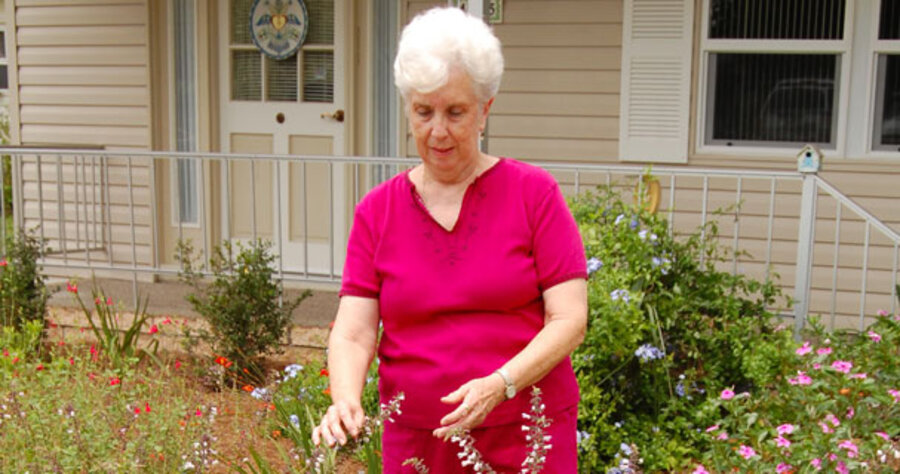In Florida, lukewarm welcome for drought-resistant landscaping
| Zellwood, Fla.
Barbara Tubb's entire yard is a garden of colorful plants and flowers. Palmetto. Pungent-smelling blue basil. And her favorite: bright white cat whiskers. Buttressed by pine needles, the yard looks to one neighbor like a fire hazard.
Inspired by environmentalism, rising water bills, and her husband's support before he died, Ms. Tubbs hired a landscape architect to design her new drought-resistant yard. The homeowner's association in the country club where she lives – a community of manufactured homes in suburban Orlando – resisted her save-water-and-the-planet attitude but eventually granted permission for her to tear out all her St. Augustine grass. Immediately, there was backlash from her neighbors; one even called the fire department.
In Florida, there seems to be little awareness of water as a limited resource, and why should there be? The state is mostly a lush, tropical landscape with lakes, rivers, and springs. Surrounded by ocean water, it gets pounded by hurricanes and tropical storms that, with other rainfall, dump up to 50 inches annually.
But some warn Florida's groundwater is nearing its limits. And people like Tubbs who uproot lush sod for less thirsty landscaping often don't get much support from their neighbors.
This summer's drought – the worst in the Southeast since record-keeping began in 1895 – has laid bare parts of Lake Okeechobee, the second-largest freshwater lake in the continental US behind Lake Michigan. It has also exposed permanent water problems in the eastern part of the nation, says Cynthia Barnett, a longtime Florida journalist and author of "Mirage: Florida and the Vanishing Water of the Eastern U.S."
She and others warn that the state may soon face water wars once unique to the arid West, a situation that eventually could reach well beyond Florida as populations grow across the eastern United States and climate changes affect water availability.
"Florida will never be arid like Arizona, but it's certainly going to have the same water problems as Arizona has," says Peter Gleick, president of the Pacific Institute, an independent nonprofit research group based in Oakland, Calif. "Florida is reaching the limits of its natural water availability. The population is growing rapidly, and it's outstripping the natural endowment."
The average Floridian household consumes 174 gallons of water daily, using up to 75 percent of it to irrigate sod and landscaping. The sod of choice is St. Augustine – grass that dies without water. In this state of golf courses and country clubs, many homeowner's associations require that a certain percentage of a homeowner's yard is sod with St. Augustine, maintained to a specific shade of green, Ms. Barnett says.
Xeriscaping – landscaping using drought-resistant and usually native plants and flowers – is catching on thanks to trailblazers like Tubbs. But it's still not mainstream in Florida. Proponents avoid using the term, because they say it's misconstrued as zero landscaping or landscaping with rocks and gravel.
Striking a balance between attractive, drought-resistant landscaping and landscaping that is unkempt is tricky, says Teresa Watkins, Central Florida yards and neighborhoods coordinator for the University of Florida. A dirt yard saves water, but it sure isn't pretty.
Very few Florida yards – perhaps fewer than 1 percent – are "Florida-friendly," says Ms. Watkins.
"We still see lawns everywhere," says Mr. Gleick. "It doesn't matter if you think you're in a state that gets a lot of water if you use it all."
In 2005, the Florida Legislature passed two laws, one requiring local governments to ensure water sources are available before approving new development and another allocating $60 million to localities to develop new water sources. Gleick warns that any real progress will have to come from local governments, because local agencies distribute water.
That's starting to happen in Florida. In Sarasota, the average household has reduced its number of gallons used daily to 90 through measures that limit the amount of sod allowed in a yard. Some residents, conscious of shortages, have asked for restrictions on water use to go even further, says Pat Haire, a Sarasota County spokeswoman.
Other municipalities are exploring ways to remove salt from sea water. In Orange County, home to Orlando, water managers are pushing for an attitude shift – starting with children, says Jacqueline Torbert of the Orange County Utilities' Water Division. They are visiting schools and promoting conservation on Radio Disney in programs broadcast throughout Central Florida. And they're encouraging home builders and homeowner's associations to landscape with less St. Augustine grass. Orange County is also developing water and landscaping ordinances.
Most golf courses in the Orlando area already use reclaimed water or reused waste water. And only about half of an average household's water is used outside, Ms. Torbert says. Though the issue gained urgency for the agency only about five years ago, time is of the essence: The agency expects the region's groundwater to reach a critical level by 2013.
Florida is unique because it is so dependent on its groundwater, says Gleick, but other parts of the country also over-pump their aquifers. He cites the Ogallala aquifer that spans Nebraska, Oklahoma, Texas, and Kansas as one example.
Nationwide it's hard to know how much water landscaping like Tubbs's saves. Landscaping in different regions requires vastly different amounts of water. But Tubbs sees a difference in her water bill – down $10 to $20 a month since her new yard went in.
"I'm willing to be the first one," she says. "I can handle [the neighbors.]"





